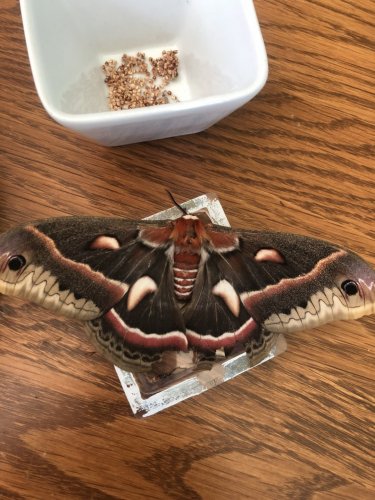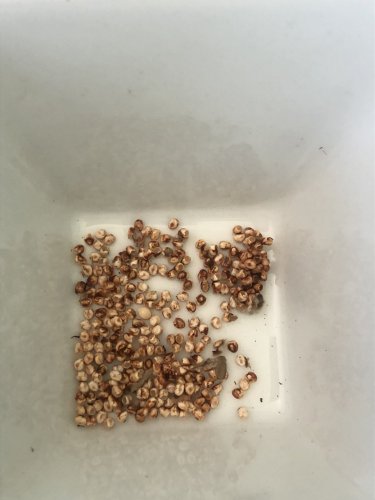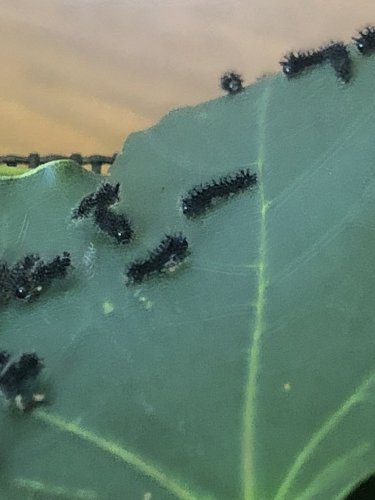Hydee
Member
My husband found this huge, beautiful moth on the grill of his vehicle a little while back and he wanted to show our kids so he put it in a box and brought it home to show our kids. Turns out, it was still alive and it started laying all kinds of eggs inside this box so after looking at it for a few minutes, we closed the box and left her to lay her eggs.
I’ve recently started breeding my own silkworms to feed my chameleon so I’ve been learning a few things. I knew she wouldn’t live long after she finished laying so we just left her in the box until we knew she was done. She was too injured to fly but her wings weren’t too damaged so we kept her to put in one of those shadow boxes to put up on the wall. Morbid, maybe but she’s very pretty and I’m into weird stuff.
Anyway, all those tiny little eggs started hatching over the last few days. I put them in one of my silkworm containers and gave them some leaves to munch on.
I tried looking it up and from what I found, this is a Hyalaphora cecropia or cecropia moth. It is the largest moth in North America. I’m very confident that I’ve identified it correctly because its size alone sets it apart from any other moth I’ve seen before. From what I read, it is a breed of silk worm. From what I’ve read so far, they are non-poisonous. What looks like hairs or barbs are false, just decoys and just soft, like the little horns on the back end of the white ones.
Would this be ok to feed my veiled chameleon? He loves silk worms and though, my breeding practices have so far been successful, keeping mulberry chow on hand has been a challenge while I wait for my mulberry bushes to grow. These worms eat all kinds of native leaves which would be very accessible to me from my own yard. Depending on what I learn from the further research I need to do, this would be a much more convenient option in regards to feeding.
What are your thoughts?
Has anyone used these as feeders before?
I’m attaching pictures for reference.
Thanks for any information you can provide.
I’ve recently started breeding my own silkworms to feed my chameleon so I’ve been learning a few things. I knew she wouldn’t live long after she finished laying so we just left her in the box until we knew she was done. She was too injured to fly but her wings weren’t too damaged so we kept her to put in one of those shadow boxes to put up on the wall. Morbid, maybe but she’s very pretty and I’m into weird stuff.
Anyway, all those tiny little eggs started hatching over the last few days. I put them in one of my silkworm containers and gave them some leaves to munch on.
I tried looking it up and from what I found, this is a Hyalaphora cecropia or cecropia moth. It is the largest moth in North America. I’m very confident that I’ve identified it correctly because its size alone sets it apart from any other moth I’ve seen before. From what I read, it is a breed of silk worm. From what I’ve read so far, they are non-poisonous. What looks like hairs or barbs are false, just decoys and just soft, like the little horns on the back end of the white ones.
Would this be ok to feed my veiled chameleon? He loves silk worms and though, my breeding practices have so far been successful, keeping mulberry chow on hand has been a challenge while I wait for my mulberry bushes to grow. These worms eat all kinds of native leaves which would be very accessible to me from my own yard. Depending on what I learn from the further research I need to do, this would be a much more convenient option in regards to feeding.
What are your thoughts?
Has anyone used these as feeders before?
I’m attaching pictures for reference.
Thanks for any information you can provide.





